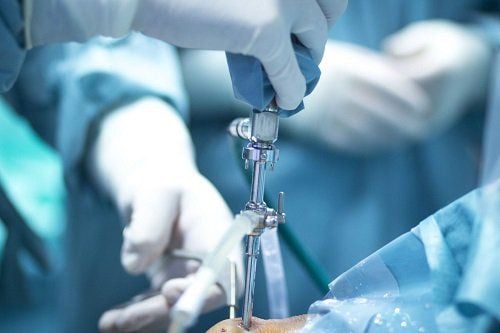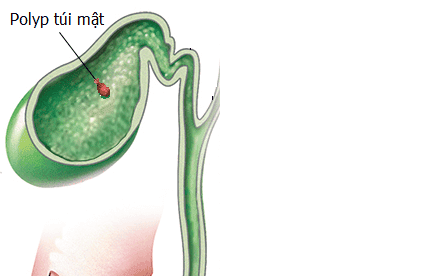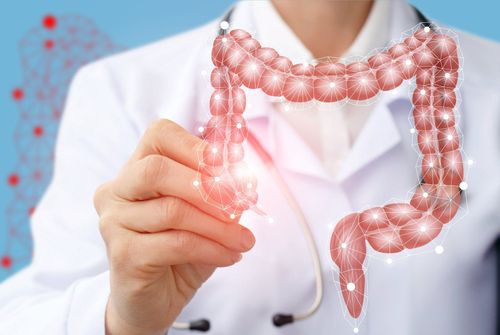This is an automatically translated article.
The article is expertly consulted by Master, Doctor Ton That Quang - Head of Anesthesia - Anesthesia Unit - Department of General Surgery - Vinmec Nha Trang International General Hospital.1. When is laparoscopic surgery to remove uterine fibroids?
Uterine fibroids are benign, fleshy tumors that develop from the muscular layer of the uterus. The patient may have one or more fibroids. Most fibroids develop in the body of the uterus, but they can also occur in the cervix, round ligaments, or broad ligaments.Uterine fibroids are a fairly common disease in women. In our country, it is estimated that uterine fibroids account for 18-20% of all gynecological diseases. The actual number may be higher because women who have fibroids but have no clinical symptoms should not seek medical attention. The cause of uterine fibroids is currently unknown, but many studies show that the disease is related to the state of estrogen hormone. The hormone oestrogen is secreted much leading to increased muscle tissue and uterine lining. When women go through menopause, the amount of estrogen in the body decreases, and fibroids may shrink or disappear.
Uterine fibroids are usually benign tumors, rarely cancerous, but they can cause many complications that seriously affect health such as:
Causes abnormal bleeding leading to anemia. The enlarged uterine fibroids will compress the ureters, bladder, colon causing urinary and digestive symptoms such as frequent urination, difficulty urinating,... Uterine fibroids can deform uterine cavity causing infertility, miscarriage, premature birth. During labor, if fibroids in the cervix will interfere with the labor process, causing abnormal fetal position. After delivery, fibroids can affect uterine contractions causing postpartum bleeding. To treat uterine fibroids, the doctor will rely on many factors such as the patient's age, the number of births, whether the patient is pregnant or not, the presence of clinical symptoms, the location of the uterine fibroids and the number of cases. fibroids in the uterus. Uterine fibroids can be treated with medicine, radiation, surgery, ... In which, surgical treatment is the most effective and thorough method.
Laparoscopic surgery to remove uterine fibroids is an increasingly popular method due to many outstanding advantages such as less invasiveness, small postoperative scars, high aesthetics, less pain for patients, less recovery time. Fast postoperative recovery.
Laparoscopic removal of uterine fibroids is usually applied for tumors larger than 5cm and smaller than 10cm, without the risk of malignancy. The doctor will make small incisions in the abdomen to insert the camera and surgical instruments. These devices make it easy for the doctor to see the tumor and safely remove the tumor, the tumor is gently removed from the body.
Anesthesia is an extremely important step for every surgery. Effective and safe anesthesia is a prerequisite for a smooth operation. Endotracheal anesthesia is the general anesthetic technique used in many laparoscopic fibroid removal surgeries.

2. Endotracheal anesthesia technique laparoscopic fibroid removal surgery
2.1. Indications Endotracheal anesthesia for laparoscopic fibroid removal is a technique of general anesthesia with intubation to help control breathing during surgery and postoperative resuscitation. The technique is indicated in the following cases:Laparoscopic surgery on patients with uterine fibroids; Difficulty mask respiratory control; Maintain anesthesia with inhalational anesthetic. This is a difficult technique, so it should not be performed if the patient does not agree or the medical facility does not have enough anesthesia and resuscitation facilities.
2.2. Preparation About People
To perform endotracheal anesthesia laparoscopic fibroid removal surgery requires an anesthetic team including doctors and nurses specializing in anesthesiology and resuscitation.
About the means of implementation
Anesthesia machine system with breathing, hand-held oxygen source, vital function monitor (ECG indicators, arterial blood pressure, SpO2, EtCO2, breathing rate, temperature), defibrillator defibrillator, suction machine... Laryngoscope, endotracheal tube of all sizes, suction tube, mask, squeeze ball, oropharyngeal cannula, Magill pliers, soft mandrin. Lidocaine 10% spray, Salbutamol spray Difficult intubation equipment includes Cook tube, laryngeal mask, flexible bronchoscope, tracheostomy kit, mouth opener,... These tools need to be prepared available for the anesthesiologist team to transition to difficult intubation procedures when conventional intubation procedures are not possible. About the patient
To prepare for endotracheal anesthesia for laparoscopic surgery to remove fibroids, the patient will be examined by an anesthesiologist before surgery to detect and prevent possible complications. . The patient will also be evaluated for difficult intubation if necessary. Medical staff will advise patients on the purpose of anesthesia as well as some complications of endoscopic anesthesia such as subcutaneous emphysema, air embolism, postoperative shoulder pain, internal bleeding,... In some cases In case of necessity, the patient will be sedated from the night before surgery.
2.3. Steps to conduct endotracheal anesthesia for laparoscopic total hysterectomy Preparation
The patient lies supine on the operating table, the anesthesia team gives the patient 100% oxygen with a flow rate of 3-6 liters/minute at least at least 5 minutes before induction of anesthesia. The nurse installed a vital signs monitor with EtCO2 parameters during laparoscopic surgery, then established an effective transmission line. Perform pre-anesthesia with fentanyl 100mcg and Midazolam 2mcg.
Induction of anesthesia
The patient will be induced with the following drugs:
Sleeping pills: use one of the drugs such as intravenous anesthetics (propofol, etomidat, thiopental, ketamine,...), volatile anesthetics ( seofluran, Isoflurane,...) Painkillers: sufentanil, fentanyl, morphine,... Muscle relaxants: rocuronium, vecuronium, succinylcholine,...used if needed. To prevent gastric reflux, the patient will be given H2-receptor antagonists (Famotidine, Ranitidine,...) and Metoclopramide. Oral endotracheal intubation
The condition for oral intubation is that the patient sleeps deeply and has sufficient muscle relaxation (in most cases). Steps to perform oral endotracheal intubation include:
Opening the patient's mouth, the doctor will put one hand under the neck to keep the neck straight, the other hand will put the laryngoscope to the right side of the mouth, slide the tongue to the side. left side. Push the lamp deeply, coordinate with the right hand to press the cricoid cartilage to find the epiglottis and glottis. Perform rapid induction of anesthesia and the Sellick maneuver in case of full stomach (press the cricoid cartilage 20-30 kg immediately before the patient loses consciousness until the intubation is complete). The doctor threaded the endotracheal tube gently through the glottis, when the balloon of the endotracheal tube passed 2-3cm through the vocal cords, it stopped. The laryngoscope is gently withdrawn, then the endotracheal balloon is inflated. To check that the endotracheal tube is in the correct position, the doctor will listen to the lungs and check the EtCO2 result. If the position is correct, fix the endotracheal tube with tape. If necessary, the cannula can be placed in the patient's mouth to avoid biting the tube. If the endotracheal intubation procedure is unsuccessfully performed, the anesthesiology team will switch to the difficult intubation procedure.

During laparoscopic surgery to remove uterine fibroids, the anesthesiology team will maintain anesthesia for the patient with:
Intravenous or volatile anesthetics, analgesics, and relaxants muscle (if needed). Monitoring the depth of anesthesia based on parameters such as heart rate, blood pressure, sweating, tearing (PRST); MAC, BIS, Entropy,... Vital signs such as heart rate, blood pressure, SpO2, EtCO2, body temperature are closely monitored. The patient's breathing is controlled by machine or hand squeeze.
Criteria for extubation
After laparoscopic removal of uterine fibroids, the endotracheal tube is removed if the patient meets the following criteria:
The patient is awake and can follow orders, spontaneous breathing, respiratory rate within normal limits, blood pressure stable. The patient can raise his head on his own for more than 5 seconds, TOF > 0.9, body temperature > 35°C and without complications of anesthesia or surgery.
3. Possible complications in endotracheal anesthesia laparoscopic fibroid removal and how to handle
3.1. If there is digestive juices in the patient's mouth and airways, the anesthesia team will immediately drain the digestive juices, let the patient lie down with his head low and tilt his head to the side. Place the endotracheal tube quickly and clear the airway. Patients will be monitored to prevent lung infections after surgery3.2. Hemodynamic disorders During endotracheal anesthesia for laparoscopic surgery to remove uterine fibroids, patients may experience hemodynamic disturbances such as: hypertension, hypotension or cardiac arrhythmias. such as: bradycardia, tachycardia, arrhythmia. Your doctor will have a specific treatment plan according to the cause and symptoms.
3.3. Possible complications due to intubation Failure to intubate:
The team will switch to a difficult intubation procedure or switch to another method of anesthesia.
Misplaced endotracheal tube into the stomach:
Anesthesia team will re-intubate the endotracheal tube. Misplaced endotracheal tube in the stomach was determined by auscultation of the lungs without alveolar murmurs, no measurement of EtCO2.
Constriction of the larynx-trachea:
Provide adequate oxygen, add sleeping pills and muscle relaxants to the patient, ensure ventilation and give bronchodilators and corticosteroids. If breathing is still not controlled, the anesthesia team will move on to perform the difficult intubation procedure.
Trauma during intubation:
Injuries that may occur during intubation such as bleeding, damage to the vocal cords, broken teeth, falling foreign bodies into the airways,... Doctor The doctor will have a specific treatment plan depending on the damage.

3.5. Complications after extubation After extubation, patients may experience complications such as respiratory failure, sore throat, hoarseness, laryngotracheal-bronchospasm, upper airway inflammation, and narrowing. larynx-trachea,... The doctor will treat according to symptoms and causes.
3.6. Complications during laparoscopy In addition to the possible complications caused by endotracheal anesthesia, patients may also experience complications due to laparoscopic surgery to remove uterine fibroids such as subcutaneous pneumothorax, pneumothorax, Cardiac arrhythmias due to anxiety, vascular wounds,... If laparoscopy is done in the Trenderlenburg position, the patient will still be at risk of atelectasis, reduced visceral blood flow, and reduced lung compliance.
To prevent the above-mentioned complications, the surgical team will control the CO2 injection pressure at 12-15mmHg; monitor hypercapnia through Capnography, keep EtCO2 not more than 50mmHg; if laparoscopy with Trenderlenburg, the head should not be lower than 15 degrees. Patients are closely monitored for timely detection and management of atelectasis, subcutaneous emphysema, pneumomediastinum, internal bleeding due to uterine perforation or the wrong path of the laparoscope,...
Vinmec International General Hospital is one of the hospitals that strictly applies safe surgical anesthesia practice standards according to international guidelines. Vinmec has a team of experienced anesthesiologists and nurses, modern equipment such as: nerve detectors, ultrasound machines, Karl Storz's difficult airway control system, comprehensive anesthesia monitoring system GE's AoA (Adequate of Anesthesia) including monitoring of anesthesia, pain and muscle relaxation will provide high quality and safety, helping patients to have adequate anesthesia, not wake up, and do not have residual muscle relaxants after surgery.
Vinmec Health System is also proud to be the first hospital in Vietnam to sign with the World Anesthesiology Association (WFSA) towards the goal of becoming the safest hospital for surgical anesthesia in Southeast Asia.
Master. Dr. Ton That Quang has more than 15 years of experience working in the Anesthesia - Resuscitation industry. Doctor Quang was a doctor at the Department of Anesthesiology and Resuscitation at Khanh Hoa General Hospital and a lecturer at the provincial level of Emergency Resuscitation in Obstetrics and Gynecology before being an Anesthesiologist and Resuscitation Doctor at the Department of General Surgery, General Hospital. International Vinmec Nha Trang.
Please dial HOTLINE for more information or register for an appointment HERE. Download MyVinmec app to make appointments faster and to manage your bookings easily.














